
|
U. S. CIVIL WAR
PHOTOGRAPHS
|

|
APPOMATTOX

(PAGE 1 OF 6)
In the text, the icon  is a link to the definition of the word it marks. is a link to the definition of the word it marks.
Use your
browser's "back" button to return to this page.
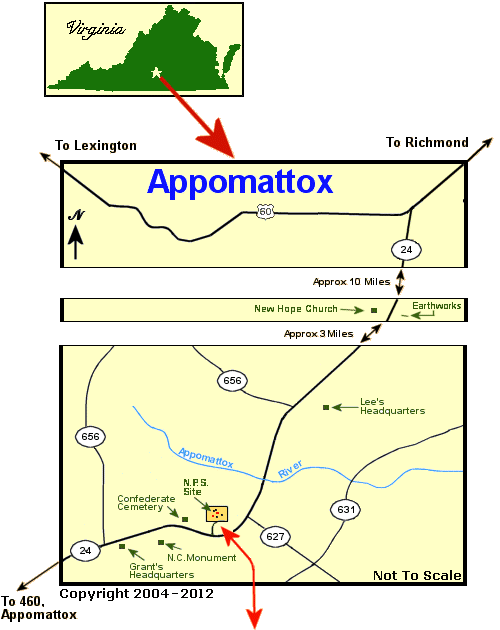
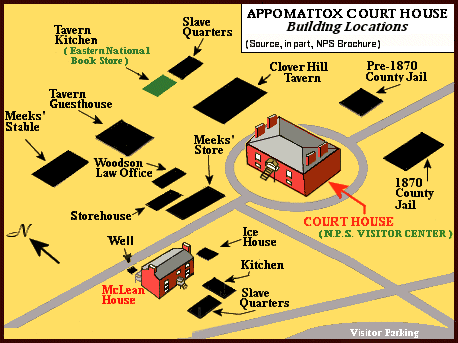
| |
April 9, 1865
Estimated Casualties : 700 total
(27,805 Confederate soldiers paroled : 700 total
(27,805 Confederate soldiers paroled ) )
Early on April 9, the remnants of John Brown Gordon's corps and Fitzhugh Lee's cavalry formed line
of battle at Appomattox Court House. Gen. Robert E. Lee determined to make one
last attempt to escape the closing Union pincers and reach his supplies at
Lynchburg. At dawn the Confederates advanced, initially gaining ground against
Sheridan's cavalry. The arrival of Union infantry, however, stopped the advance
in its tracks. Lee's army was now surrounded on three sides. Lee surrendered to
Grant on April 9. This was the final engagement of the war in Virginia. and Fitzhugh Lee's cavalry formed line
of battle at Appomattox Court House. Gen. Robert E. Lee determined to make one
last attempt to escape the closing Union pincers and reach his supplies at
Lynchburg. At dawn the Confederates advanced, initially gaining ground against
Sheridan's cavalry. The arrival of Union infantry, however, stopped the advance
in its tracks. Lee's army was now surrounded on three sides. Lee surrendered to
Grant on April 9. This was the final engagement of the war in Virginia.
(Text Source:
U.S. Gov't, National Park Service)
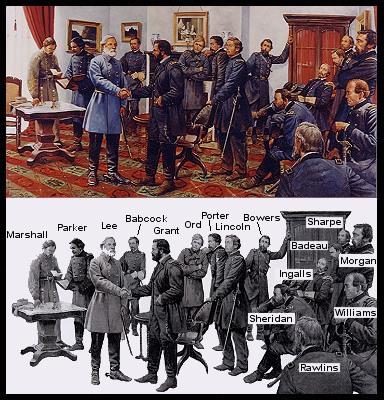 160 160
The Surrender at Appomattox, by Keith Rocco
(Source: National Park Service -
Appomattox)
LEE'S REPORT OF THE SURRENDER
Near Appomattox Court House, Virginia
April 12, 1865
To: Jefferson Davis
Mr. President:
It is with pain that I announce to Your Excellency the surrender of the Army
of Northern Virginia.
The operations which preceded this result will be reported in full. I will
therefore only now state that upon arriving at Amelia Court House on the
morning of the 4th with the advance of the army, on the retreat from the
lines in front of Richmond and Petersburg, and not finding the supplies
ordered to be placed there, nearly twenty-four hours were lost in endeavoring
to collect in the country subsistence for men and horses. This delay was
fatal, and could not be retrieved.
The troops, wearied by continual fighting and marching for several days
and nights, obtained neither rest nor refreshment; and on moving on the 5th,
on the Richmond and Danville railroad, I found at Jetersville the enemy's
cavalry, and learned of the approach of his infantry and the general advance
of his army toward Burkeville.
This deprived us of the use of the railroad, and rendered it impracticable
to procure from Danville the supplies ordered to meet us at points of our
march. Nothing could be obtained from the adjacent country. Our route to the
Roanoke was therefore changed, and the march directed upon Farmville, where
supplies were ordered from Lynchburg.
The change of route threw the troops on the roads pursued by the artillery
and wagon trains west of the railroad, which impeded our advance and
embarrassed our movements. On the morning of the 6th General Longstreet's corps
reached Rice's station on the Lynchburg railroad. It was followed by the
commands of Generals R.H. Anderson, Ewell, and Gordon, with orders to close
upon it as fast as the progress of the trains would permit or as they could be
directed (diverted) on roads father west.
General Anderson, commanding Pickett's and B.R. Johnson's divisions, became
disconnected with Mahone's division, forming the rear of Longstreet. The
enemy's cavalry penetrated the line of march through the interval thus left,
and attacked the wagon train moving toward Farmville. This caused serious
delay in the march of the center and rear of the column, and enabled
the enemy to mass upon their flank. After successive attacks Anderson's and
Ewell's corps were captured or driven from their position. The latter
General, with both of his division commanders, Kershaw and Custis Lee, and
his brigadiers, were taken prisoners.
Gordon, who all the morning, aided by General W.F. Lee's cavalry, had checked
the advance of the enemy on the road from Amelia Springs and protected the
trains, became exposed to his combined assaults, which he bravely resisted
and twice repulsed; but the cavalry having been withdrawn to another part of
the line of march, and the enemy, massing heavily on his (Gordon's) front and
both flanks, renewed the attack about 6 P.M., and drove him from the field
in much confusion.
The army continued its march during the night, and every effort was made to
reorganize the divisions which had been shattered by the day's operations.
But the men being depressed by fatigue and hunger, many threw away their
arms, while others followed the wagon trains and embarrassed their progress.
On the morning of the 7th rations were issued to the troops as they passed
Farmville, but the safety of the trains requiring their removal upon the
approach of the enemy all could not be supplied. The army, reduced to two
corps under Longstreet and Gordon, moved steadily on the road to Appomattox
Court House. Thence its march was ordered by Campbell Court House, through
Pittsylvania, toward Danville. The roads were wretched and the progress
of the trains slow.
By great efforts the head of the column reached Appomattox Court House on the
evening of the 8th, and the troops were halted for rest. The march was ordered
to be resumed at 1 A.M. on the 9th. Fitz Lee, with the cavalry, supported
by Gordon, was ordered to drive the enemy from his front, wheel to the left,
and cover the passage of the trains, while Longstreet, who from Rice's Station
had formed the rear-guard, should close up and hold the position. Two
battalions of artillery and the ammunition wagons were directed to accompany
the army, the rest of the artillery and wagons to move toward Lynchburg.
In the early part of the night the enemy attacked Walker's artillery train
near Appomattox Station on the Lynchburg railroad, and were repelled. Shortly
afterward their cavalry dashed toward the Court House, till halted by our
line.
During the night there were indications of a large force massing on our
left and front. Fitz Lee was directed to ascertain its strength, and to
suspend his advance till daylight if necessary. About 5 A.M., on the 9th,
with Gordon on his left, he moved forward and opened the way. A heavy force
of the enemy was discovered opposite Gordon's right, which, moving in the
direction of Appomattox Court House, drove back the left of the cavalry and
threatened to cut off Gordon from Longstreet. His cavalry at the same time
threatening to envelop his left flank, Gordon withdrew across the Appomattox
River, and the cavalry advanced on the Lynchburg road and became separated
from the army.
Learning the condition of affairs on the lines, where I had gone under the
expectation of meeting General Grant to learn definitely the terms he
proposed in a communication received from him on the 8th, in the event
of the surrender of the army, I requested a suspension of hostilities until
these terms could be arranged. In the interview which occurred with General
Grant in compliance with my request, terms having been agreed on, I
surrendered that portion of the Army of Northern Virginia which was on the
field, with its arms, artillery, and wagon-trains, the officers and men to be
paroled, retaining their side-arms and private effects. I deemed this course
the best under all the circumstances by which we were surrounded.
On the morning of the 9th, according to the reports of the ordnance officers,
there were 7892 organized infantry with arms, with an average of 75 rounds
ammunition per man; the artillery, though reduced to 63 pieces with 93 rounds
of ammunition, was sufficient. These comprised all the supplies of ordnance
that could be relied on in the State of Virginia. I have no accurate report
of the cavalry, but believe it did not exceed 2100 effective men. The enemy
was more than five times our numbers. If we could have forced our way one day
longer it would have been at a great sacrifice of life, and at its end I did
not see how a surrender could have been avoided. We had no subsistence for
man or horse, and it could not be gathered in the country. The supplies
ordered to Pamplin's Station from Lynchburg could not reach us, and the men,
deprived of food and sleep for many days, were worn out and exhausted.
With Great Respect
Your Obedient Servant
R.E. Lee
Genl.
[ In an April 20, 1865 letter from Richmond, Lee reported to Davis that when
stragglers and others heard of the surrender they turned themselves in,
increasing the number surrendering to 26,018. -Ed. ]
(Source: "Battles and Leaders of the Civil War"; "The Written Papers of
Robert E. Lee", edited by Clifford Dowdy and Louis H. Manarin; and others.)
|
NEW HOPE CHURCH
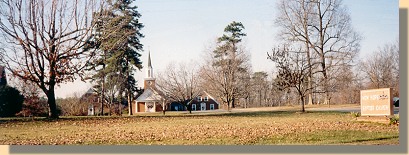
Modern New Hope Church - 2004

Longstreet's Earthworks near New Hope Church
This is where General James Longstreet's corps entrenched early in the
morning of April 9, 1865, to protect the rear of the Army of Northern
Virginia. General Robert E. Lee and most of the army bivouacked about
four miles south, just short of Appomattox Court House, the county seat.
Here looking down the Confederate picket line, you can see remnants of
Longstreet's earthworks, the last built in the field by the army that had
become renowned for its quick and effective construction. (Source:
National Park Service - Interpretive Sign).
|
|
PAGE TWO
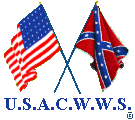 >
Civil War Photos
>
Appomattox
>
Page 2
>
3
>
4
>
5
>
6
>
Civil War Photos
>
Appomattox
>
Page 2
>
3
>
4
>
5
>
6
Notes
|
|









